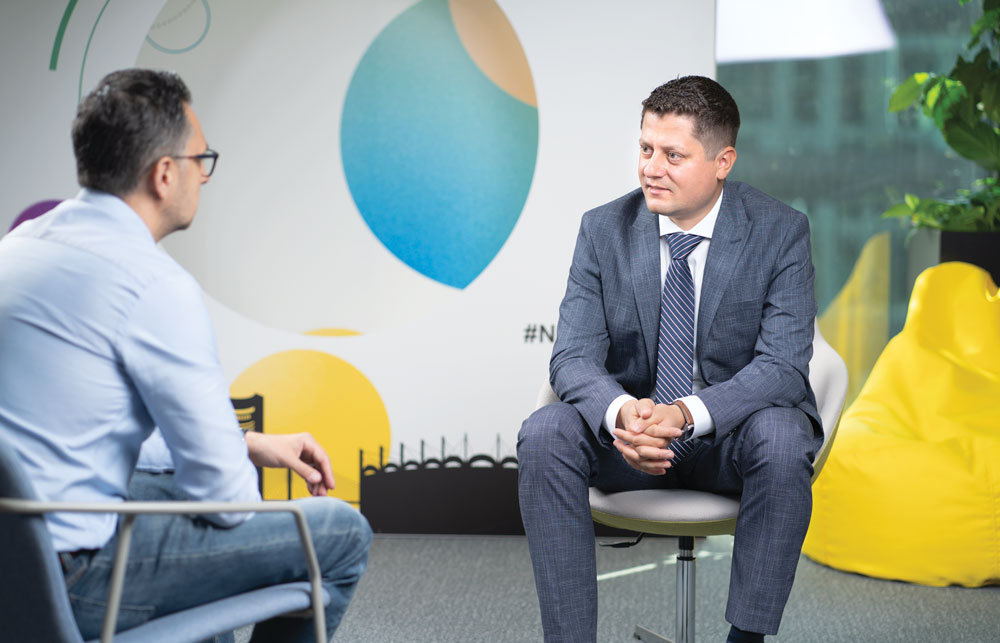Ciprian Oarga, Country Manager Romania: Schlumberger Getting Ready for the ‘Net Zero Era’
Ciprian Oarga, Country Manager Romania at Schlumberger, spoke about the new business models, the role of technology and innovation in sustainable energy transition and the company’s strategy to achieve net-zero GHG.
Schlumberger is a technology company that partners with customers to access energy. Their people, representing over 160 nationalities, are providing leading digital solutions and deploying innovative technologies to enable performance and sustainability for the global energy industry. With expertise in more than 120 countries, Schlumberger collaborates to create technology that unlocks access to energy for the benefit of all.
Ciprian Oarga is an experienced manager with a demonstrated history of working in the oil & energy industry. Skilled in Petroleum Engineering, Operations Management and Continuous Improvement. A strong sales professional with a Master of Engineering (M.Eng.) in Surveying Engineering from 1 Decembrie 1918 University, Alba Iulia.
Mr. Oarga, after more than 13 years at Schlumberger, in Romania and abroad, how would you describe your work experience to date?
Ciprian Oarga: I can say that Schlumberger has offered me the opportunity to travel the world and meet extraordinary people.
Schlumberger continues to be the number one service company in the E&P industry due to its people. Schlumberger has always built their business on two key pillars, people and technology.
I have had the opportunity to hold multiple roles, from engineer, to instructor, to quality and operations manager. The last couple of years have taught me that teamwork and collaboration are key to working in the energy industry.
At Schlumberger we put customer centricity at the core of everything we do and through collaboration with our customers we believe that we can build a brighter tomorrow from which we can all benefit.
We live in a world that is constantly changing. The energy industry is changing, with new digital technologies enabling greater control, optimisation, and analytics. Please explain in a few words what does this mean for Schlumberger?
Ciprian Oarga: Schlumberger has always been at the forefront of technology and we are proud of the investment we make in research and development. Over the last few years, we have seen a dramatic shift into digital and Schlumberger is a leader in developing these technologies.
The energy market is also transitioning to a more sustainable model. To help customers achieve more sustainable operations it is imperative that our services continue to drive efficiency, reliability and performance. We are committed to building sustainable operations across the entire exploration and production (E&P) value chain.
Schlumberger is focused on creating technology that unlocks access to energy in this new environment. Customer centricity, digital enablement and sustainability are all elements of our strategy.
Schlumberger is leveraging its digital investment internally while incorporating sustainability into engineering and operational practices, in addition to working closely with suppliers. This allows us to mitigate risk, enhance efficiency and more proactively reduce harmful environmental impacts from our operations.
Our industry must deliver safe and more sustainable means to provide access to energy and we must leverage digital enablement to deliver more sustainable operations and to positively impact the communities where we live and work.
The approach Schlumberger is taking is not limited to technology innovations, although that is certainly part of the mix. Much of the focus is on the opportunity of locality and regionality – not only reducing emissions where and how they happen, but also addressing energy generation where the energy usage happens.
Schlumberger is a long-term player in the region – what is your local content strategy in Romania?
Ciprian Oarga: Schlumberger logged the first wireline log in Romania back in 1931. Today we have more than 2000 employees and several facilities in Romania supplying products and services not only in Romania but across Europe.
Schlumberger now has 28 years of continuous operations in Romania. We are very proud of our long-standing presence and history here and we are ready to help Romania towards its goal of energy independence.
The state-of-the-art operational base in Ploiesti services not only Romania but acts as a hub for all surrounding countries, where we maintain equipment and deliver services to our customers in Hungary, Poland, Ukraine, Germany, Turkey and others.
We are also excited to be part of the Neptune Deep Project in the Black Sea and look forward to delivering another deep-water project here.
The region is an essential part of our business growth strategy and we are committed to completing all our current projects and look forward to the future and the activity increase expected in Eastern Europe and the Black Sea region.
Governments and companies worldwide are pledging to achieve net-zero emissions of greenhouse gases. What would it take for Schlumberger to fulfil that ambition?
Ciprian Oarga: Our approach to climate change and energy transition includes decarbonising the oil and gas value chain and investing in low-carbon energy.
In December 2019, we were the first company in the upstream E&P services sector to announce its commitment to setting a science-based target to reduce its GHG emissions, aligning us with the environmental goals of the Paris Agreement.
In June 2021 we announced our commitment to Net Zero by 2050. With minimal reliance on offsets, we are focused on reducing Scope 1, 2 and 3 emissions across the entire value chain aligned with a science-based carbon budget, leveraging technology to address operational emissions, customer emissions and carbon-negative actions.
To reduce our operations emissions, we have begun to convert facilities to renewable power and electrify our fleet. In addition, digital adoption will play a role in reducing waste – and consequently emissions – out of operations.
To support our customers in their efforts to reduce operational emissions, the company has introduced its Transition Technologies portfolio, which addresses fugitive emissions, flaring reduction, electrification, well construction emissions, and full field development solutions.
In 2020, we created Schlumberger New Energy to explore new businesses in low carbon or carbon neutral energy technologies. Leveraging Schlumberger’s 90+ year expertise in the industrialization of technologies and their deployment in tough environments, our ability to create strong partnerships and our industry leading digital capabilities, we have developed activities in lithium, hydrogen, energy storage, carbon capture, geo-energy and geothermal.
And we believe the future of our industry lies in collaboration – not just within our industry, where taking a new perspective on how we work together can speed decarbonization of our operations – but in partnerships with other industries that can accelerate the speed to innovations that will impact industries beyond ours.
In Schlumberger, we believe many of the key aspects of how our industry can, and must change, hinge on collaboration. Going forward, we must step up industry collaboration, which can only be fully achieved with a mindset of partnership and alignment throughout the entire value chain.
To make the impact we need by 2050, we must do this not just in oil and gas, but many other industries where energy expertise can help decarbonize more quickly. Industries must share knowledge and work toward solutions together, combining domain expertise, which will accelerate innovation and create mutual value much faster than can be achieved in isolation.

Last year, Schlumberger announced its commitment to achieve net-zero greenhouse gas (GHG) emissions by 2050 and the introduction of the Transition Technologies portfolio. What would be the role of this instrument?
Ciprian Oarga: Yes, as previously mentioned we launched our Transition Technologies portfolio to support our customers and help them achieve their emission reduction goals. The portfolio is comprised of technologies and solutions that enable more sustainable operations while simultaneously driving efficiency, reliability, and performance.
To support the Transition Technologies portfolio, we have established a comprehensive framework that enables consistent impact quantification of the broad range of products and services offered by Schlumberger. Only those technologies that have passed through this process and meet internal thresholds for this quantified impact are qualified as Transition Technologies. Our Transition Technologies support the UN Sustainable Development Goals and are mapped to quantifiable solution attributes that enable our customers to make more informed choices.
What are the road map and next steps along this journey to low carbon transition?
Ciprian Oarga: Our climate action focus is on developing detailed road maps to net zero, continuing to decarbonize our operations and our customer’s operations, and embracing new energy and transition opportunities.
It goes without saying that climate action is bigger than just ourselves and our industry, so we need to step up collaboration to accelerate the speed to innovation. This is all underpinned by robust governance and a coherent GHG emission accountancy framework so that as an industry we can be transparent and move together in the right direction.
As a global technology leader, is Schlumberger considering new technologies and perspectives for achieving carbon neutrality?
Ciprian Oarga: Absolutely. Our culture of science, innovation and track record of technology commercialization make us a strong partner to scale new low-carbon innovations. As mentioned, we are developing low-carbon energy technologies toward scale commercialization in Schlumberger New Energy, but we are also decarbonizing with CCS.
We have already engaged with partners to develop carbon storage solutions to proactively remove CO2 in some hard-to-abate industries. For example, we recently entered into a technology-driven partnership with LafargeHolcim to explore CCS solutions for the cement industry. Using our carbon storage technologies, this partnership paves the way for both companies to make strong inroads in carbon solutions.
Complementing our Transition Technologies Portfolio, our newly launched Schlumberger end to end emissions solutions (SEES), offers a tailorable end-to-end solution to help our customers in methane detection, monitoring and abatement and routine flaring monitoring and elimination. To support this service, we have access to a uniquely wide range of technologies and our industry leading domain knowledge allows us to identify the most effective plan and approach for decarbonizing any operator’s assets.
OPEC projects global oil demand to peak around 2040, estimating that the world’s thirst for oil will stop growing in about 20 years. What is your outlook for the oil and gas industry in the future?
Ciprian Oarga: The Oil and Gas industry will rise to meet the demands of net zero by 2050, this does not mean an end to Oil and Gas but that we will have to be smarter how we use energy and eliminate the waste products of that consumed energy (CCUS).
Oil and Gas are not only used to heat homes and fuel vehicles, but we also need to remember that a large part of Oil and Gas are feed stocks into the petrochemical industry, fertilizer production to feed the world, and many other industries. We need to be more responsible on how we use it and how we clean up the by-products.
Over the coming decades, oil and gas demand, decarbonization, and the energy transition will continue to transform the industry at scale. Increased capital investment will be required to support cyclical expansion within oil and gas, while also accelerating the decarbonization of operations.
The investment required to transition to a lower carbon energy system will be large in scale to evolve the energy mix, scale technology, and build infrastructure. Fundamental to this is digitalization which will transform energy efficiency and enable increased flexibility in energy systems.

Experts say the energy transition brings both challenges and opportunities. What’s your view for the future of energy and how do you think we’ll be able to develop technology to power a safe and fair energy transition?
Ciprian Oarga: Yes! The energy transition provides many exciting opportunities now – and in the future. Innovation and discovery are core to who Schlumberger is.
I think that energy consumption is not going to reduce, we are just going to see different forms of energy production in the future. Oil and Gas have been the catalyst for the global growth over the last 100 years, I believe that this growth, going forward, will be sustained by using alternative forms of energy.
I have faith in the old adage “necessity is the mother of invention” and I believe that we are going to see a new portfolio of energy sources emerge – some will have a global footprint like hydrogen, other will be local like wind, waves or solar.
Like the Oil and Gas industry 100 years ago, out of which were born the great energy companies we know today, there will be new innovative players emerge who will lead the way. Schlumberger wants to be their Technology Partner right in the centre of the new energy revolution.
We’ve evolved as a business over the past 90+ years and always will. Our industry is one of the most exciting to be part of and whatever the future of energy, we’ll be driving its technological frontier.







